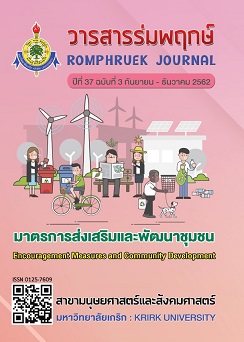The Development of Emotional Intelligence of Virtual Reality for Undergraduate Students
Main Article Content
Abstract
Virtual Reality (VR) is the technology that mix the real and the virtual world by using the aurasma applications. Students became more excited to see the picture as they touched the real thing. In addition, virtual technology allowed them to join in that activity directly. It showed that VR could be used to create new form of presentation. The undergraduates could have the ability to manage their own and other emotions, that is to say, to use their own intelligence to manage their own and other students’ emotions according to age and position in society. This so-called ability helped create happiness with high emotional intelligence into the students. For those who possessed high emotional intelligence, they were well-behaved, logical and good-hearted persons. Therefore, the use of VR in teaching and learning for the undergraduate students would help develop the students’ emotional intelligence.
Article Details
Every article published in the Romphruek Journal of the Humanities and Social Sciences is the opinion and point of view of the authors. Thery're not the viewpoint of Krirk University or the editored department. Any part or all of the articles for pablication must be clearly cited.
References
กรมสุขภาพจิต. (2550). แบบวัดความฉลาดทางอารมณ์ของประชากรไทยอายุ 12 - 60 ปี. กรุงเทพฯ : กรมสุขภาพจิต.
ธนีวรากานต์ ณัฏฐ์ชนะกุณ และ เนติรัฐ วีระนาคินทร์. (2561). การพัฒนาสื่อแอนิเมชันเพื่อปลูกฝังคุณธรรมโดยใช้เทคนิค
การนำเสนอแบบสตอรี่ไลน์สำหรับนักเรียนประถมศึกษาปีที่ 6. วารสารร่มพฤกษ์, 36(2), 76-97.
นงคราญ ศรีสะอาด และ คณะ. (2557). การสร้างสภาพแวดล้อมทางการเรียนจากเทคโนโลยีเสมือนจริง โดยใช้
กระบวนการสืบเสาะหาความรู้ เพื่อพัฒนาทักษะกระบวนการทางวิทยาศาสตร์ เรื่องระบบสุริยะสำหรับนักเรียน
ชั้นประถมศึกษาปีที่ 4. รายงานสืบเนื่องจากการประชุมสัมมนาทางวิชาการ มหาวิทยาลัยเทคโนโลยีราชมงคล
ตะวันออก ครั้งที่ 7, 7(1), 13.
เนารุ่ง วิชาราช. (2558). การพัฒนาสื่ออิเล็กทรอนิกส์ เรื่องประชาคมอาเซียนด้วยเทคโนโลยีออรัสมา.
วารสารวิชาการและวิจัยสังคมศาสตร์, 10(ฉบับพิเศษ), 615-622.
ไพฑูรย์ ศรีฟ้า. (2555). การผลิตสื่อการเรียนการสอนยุคใหม่สไตล์AURASMA. กรุงเทพฯ : มหาวิทยาลัยเกษตรศาสตร์.
วศกร เพ็ชรช่วย. (2557). การพัฒนาสื่อความจริงเสมือนบนเอกสารประกอบการเรียนเรื่องอุปราคาสำหรับนักเรียน
ชั้นมัธยมศึกษาปีที่ 3. คณะศึกษาศาสตร์ มหาวิทยาลัยเกษตรศาสตร์. กรุงเทพฯ.
วิเชียร วิทยอุดม, เขมมารี รักษ์ชูชีพ, จิรศักดิ์ สุรังคพิพรรธน์ และ อิศราภรณ์ เทียมศร. (2555). ปัจจัยที่มีอิทธิพล
ต่อการพัฒนาความฉลาดทางอารมณ์ของนักศึกษามหาวิทยาลัยเทคโนโลยีราชมงคลธัญบุรี.
วารสารปัญญาภิวัฒน์, 3(2), 73-88.
วีระวัฒน์ ปันนิตามัย. (2545). เชาวน์อารมณ์ (EQ) : ดัชนีวัดความสุขและความสำเร็จของชีวิต. กรุงเทพฯ : เอ็กซ์เปอร์เน็ท.
วัฒนา พรหมอุ่น. (2551). Virtual Reality Technology. (10 มกราคม 2562) สืบค้นจาก
https://www.docstoc.com/docs/28427384/Virtual-Reality-Technology.
ศิริพร พงศ์ศรีโรจน์. (2558). ความท้าทายของอุดมศึกษาไทยในการเข้าสู่ประชาคมอาเซียนในปี พ.ศ.2558.
วารสารร่มพฤกษ์, 33(1), 26-55.
สาโรจน์ บุญพันธุ์. (2556). ความสัมพันธ์ระหวางความฉลาดทางอารมณ์กับผลสัมฤทธิ์ทางการเรียน
วิชาวิทยาศาสตร์ของนักเรียนชั้นประถมศึกษาปีที่ 6 อำเภอบางซ้าย. คณะครุศาสตร์ มหาวิทยาลัยราชภัฏจันทรเกษม, กรุงเทพฯ.
สุบิน ไชยยะ. (2560). การใช้เทคโนโลยีเสมือนจริงในห้องสมุดประชาชน. วารสารบรรณศาสตร์ มศว., 10(2), 134-149.
สำนักงานคณะกรรมการการอุดมศึกษา. (2550). กรอบแผนอุดมศึกษาระยะยาว 15 ปี ฉบับที่ 2 (พ.ศ.2551–2565).
กรุงเทพฯ : โรงพิมพ์แห่งจุฬาลงกรณ์มหาวิทยาลัย.
อุษา วรทุน และ พรพรรณ ประจักษ์เนตร. (2562). การเปิดรับและทัศนคติของผู้รับสาร : กรณีศึกษาเนื้อหา ทางด้านเพศ
ภาษา ความรุนแรง ภาพตัวแทน ในนิยายแชทแอปพลิเคชันจอยลดา (Joylada). วารสารร่มพฤกษ์, 37(1), 80-92.
Barkhordari, M. & Rostambeygi, P. (2013). Emotional intelligence in nursing student.
Journal of Advance in Medical Education and Professionalism, 1(2), 46-50.
Bar-On, R. (2004). The Bar-On emotional quotient inventory (EQ-i) : rationale, descrip tion and summary
of psychometric properties, in Geher, G. (Ed.). Measuring emotional ntelligence : common ground and controversy. New York : Nova.
Billinghurst, M., Kato, H., & Poupyrev, I. (2001). Collaboration with tangible aug-mented reality interfaces.
HCI international, 1, 5–10.
Cooper, R. K. & Sawaf, A. (1997). Executive EQ intelligence in leadership and organization.
New York : Grosset/Putnam.
Dibrova, A. (2016). AR books and pre-school children's engagement. Malmo University, Sweden.
Matthews, G., Zeidner, M. & Roberts, R. D. (2002). Emotional intelligence : Science And myth.
Cambridge MA : MIT Press.
NC state university libraries. (n.p.). WolfWalk app. (January, 2019 ) Retrieved from
http://www.lib.ncsu.edu/documents/dli/projects/wolfwalk/screenshots/web.
Pfeiffer, T. & Pfeiffer-Leßmann, N., (2018). Virtual Prototyping of Mixed Reality Interfaces with
Internet of Things (IOT) Connectivity. I-com, 17(2), 179-186.
Richburg, M. & Fletcher, T. (2002). Emotional intelligence : Directing a child’s emotional education.
Child Study Journal, 32, 31-38.
Rogers, Y., & Price, S. (2009). How mobile technologies are changing the way children learn. In A. Druin (Ed.). Mobile technology for children : Designing for interaction and learning (pp. 3–22). UK : Elsevier.
Siriborvornratanakul, T. (2018). Enhancing User Experiences of Mobile-Based Augmented
Reality via Spatial Augmented Reality : Designs and Architectures of Projector-Camera Devicesn Article.
In Advances in Multimedia 2018, 1, 1-17.
Wiggle Planet. (2015). Wiggle Planet in the News : Petaluma startup’s educational app plays with reality.
(January, 2019) Retrieved from https://becunningand fulloftricks.com/tag /augmented-reality.


